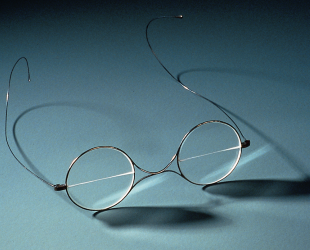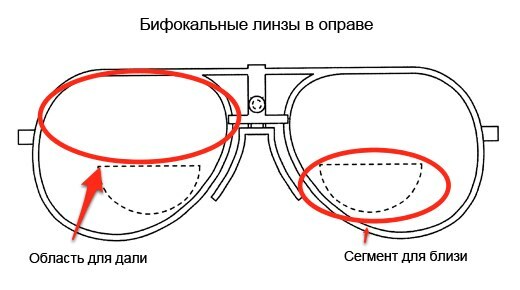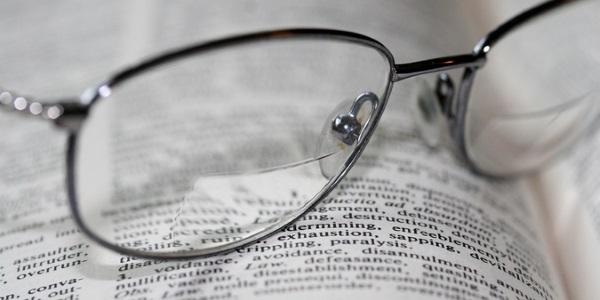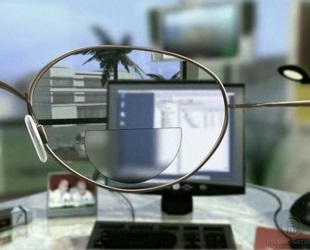
Diseases associated with a decrease in visual acuity, initially prevent seeing only one range of distances: to close or long distances.
But as they develop and further deterioration of vision, the ability to clearly distinguish objects at other distances is lost.
This happens with progressive myopia, especially in the elderly, when the original myopia is complemented by senile hyperopia.
In such cases, there will not be enough glasses optimized to refract only the near or far image, you need lenses that will allow refracting light waves of any length. Such lenses are called bifocal.
- 1. What is it?
- 2. Pros and Cons of
- 3. How to choose?
- 4. Price
- 5. Results of
- 6. Video of
What is it?
Such glasses are similar in shape to the usual ones, but their lenses differ. Bifocal glasses have two different lenses connected in one glass. Each lens has its own refractive power of the light entering into it.
Typically, one of them refracts light in order to help see distant objects, and the other refracts light to get a clear picture of near objects.
Therefore, a person does not need to carry two pairs of glasses, he can focus on one of the parts of the glass and see any objects well.
A greater emphasis is placed on the lower lens when making such glasses. This is due to the fact that it carries a specific function of switching views on the discrimination of close objects and the refraction of the image from them.
This function is more important in everyday life and in many kinds of professional activity. Also, this arrangement is established due to the fact that when looking at small and intimate objects, the view is most often directed downward( reading a book on a table, viewing a computer screen, embroidering, etc.).
When viewed from afar, it is directed at the center of the eye or at the top of the eye. But in some cases, the "near" lens can fill the top of the glass.

Because of the ability to quickly change the focus, bifocals are widely used by watchmakers, jewelers, text editors, representatives of other professions where work with small objects is important.
There are cases when the place of the top lens is inserted ordinary glass without diopters. Such glasses are used by people who suffer only with myopia without other visual acuity problems.
If they wear ordinary glasses, then they see well when reading, and distant objects look vague, since they do not need lenses with dioptres. In this case, the lens is inserted only into the lower part of the frame.
The lower lens is manufactured in various shapes that can meet both aesthetic needs and practical. It can be rounded and rectangular, occupying exactly half the glass or a smaller part of it.
Schematically they look like this:

Indeed, their use in many ways helps to see "in a new way", however, do not forget about the revival of your vision. For example, exercise at home can be improved with farsightedness.
Pros and Cons of
The advantages of bifocals include:
- , there is no need to wear two different pairs of glasses;
- availability - bifocals are slightly more expensive than classic ones;
- the ability to fine tune the refractive power of lenses and their sizes to suit the individual characteristics and needs of each person.
Has such a design and disadvantages. Still, it is considered the simplest of a group of multifunctional glasses, so it has those flaws that were eliminated by later and perfect technical solutions:
- in some activities( driving), there is a need for a long-term use of the central view zone.
Bifocals do not allow this, because in them the lenses are strictly divided between the lower and upper zones. This defect is corrected by trifocal glasses, their glass has three lenses of different strength.
- bifocal glasses refract the appearance of the eye for an outside observer: its lower part increases and the upper part decreases. This can be unacceptable from the aesthetic side for some people;
- constant switching of focus between lenses of different sharpness can create additional load on the eye and tire it. For this reason, the difference in diopters between the two pieces of glass can not be more than 4-5.
This defect is corrected by progressive lenses, where the number of diopters changes very smoothly, without sharp separations.

How to choose?

First of all, it is necessary to determine what kind of refraction will be on each of the lenses. In most cases, a minus lens is sufficient at the bottom and zero( ie, without refraction) of the lens at the top.
Such glasses are suitable for those who do not see well near, but normally sees distant objects, that is, for the case of classical myopia.
The negative lens at the bottom and the plus at the top are suitable for those cases when a person sees badly both in the distance and in the vicinity. Most often these glasses are assigned to the elderly.
In specific circumstances, glasses are used where the minus zone is at the top. They may be needed for those people who need to look at small and intimate objects located above their eye level.
The ratio of lens sizes depends on how often it is used. So, if you intend to use reading glasses more often than to consider distant objects, then the bottom lens should be half of the entire surface.
If the consideration of small objects is assumed sporadically, then it suffices to give a small place for the minus lens in the lower corners of the glass in the region of its transition to the bridge of the nose.
Price

The price of bifocals varies significantly. Budget options in Russia can cost from 500 to 1000 rubles, but there are expensive options that are individually tailored to order. Their price can reach up to 10 thousand rubles.
In Ukraine, they cost about the same in terms of UAH: 300-2000 hryvnia for a variant of the average price range.
More information about eye accessories:
- Choosing glasses for working with a computer
- What is the curvature of lenses?
- At what age can I wear a lens?
Results of
Bifocals are the best option for use by those people who constantly have to change the direction of sight from near to far.
They contain two lenses in one glass, which allow you to change the focus among themselves in order to consider objects of a particular range.
Such glasses have a number of drawbacks, which are corrected by more sophisticated and expensive technical options.
Video
We suggest you read this article:
